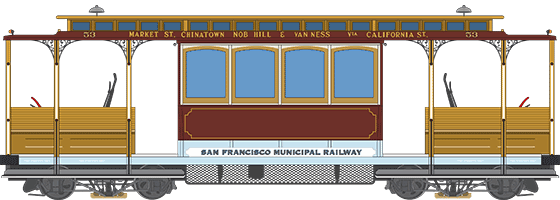California Street Cable Car 53 was built in 1907 by W.L. Holman Co. of San Francisco, which supplied most of the replacement fleet for the California Street Cable Railroad Co. after the 1906 earthquake and fire, and which five years later built the first ten streetcars for the new Municipal Railway (Muni).
While the basic paint scheme of this cable car is very similar to most other California Street cars, it is unique because it carries special touches reflecting its 2024 dedication to the late, great Tony Bennett, whose rendition of “I Left My Heart in San Francisco” has become the City’s anthem and has helped attract many millions of visitors to place where “little cable cars climb halfway to the stars.”

The most distinguishing touch on Car 53? The distinctive “ribbons” on the ends that describe the route served by other California Street cable cars here pay tribute to Bennett’s song by reading “Halfway to the Stars…Since 1873” (the year the cable car was invented here by Andrew Hallidie). Additional details include a dedication plaque to Bennett on each end of the car, a tribute plaque to the song’s composer and lyricist, George Cory and Douglas Cross, and musical notations on the roof letterboard with the first notes of the song and the notation “dedicated to Tony Bennett”
Beyond the special touches, Car 53 adheres to the basic design introduced in 1891 by the California Street Cable Railroad Company, often known as “Cal Cable.”
This design, considered revolutionary by some experts at the time, featured a closed center section flanked by open sections on each end. The car could be operated from either end, and thus did not require a turntable or turning loop. This easily reversible vehicle design was quickly dubbed the “California type” and was widely adopted throughout the western United States for both cable cars and streetcars. Indeed, the California design served for half a century as the standard streetcar model in San Francisco for both Muni and its private competitors.
Cal Cable’s original fleet of cars was completely destroyed in the 1906 earthquake and fire. Over the following few years, the company built a new fleet of cable cars very much like the originals but with corner posts and windows on the ends for greater strength. Separate fleets of these cars served the California Street line, which ran from Market Street to Presidio Avenue, and the O’Farrell, Jones & Hyde line. (Three shorter cable cars were used on a shuttle service on Jones Street between Market and O’Farrell.)
In 1952, Muni took over the financially insolvent California Street Cable Railroad Co. After a ferocious political fight, voters approved a realignment of Muni’s cable car system that saw the California line lose half its length, cut back to Van Ness Avenue, while the O’Farrell, Jones & Hyde line and the Powell line that ran along Washington and Jackson Streets to Pacific Heights were discontinued in favor of a new Powell-Hyde line that used pieces of each.
The best cable cars from both the California and O’Farrell, Jones & Hyde lines were kept and repainted for the truncated California Street line, which reopened in 1957. The rest were sold or turned into playground structures.
Of today’s California Street cable car fleet, only two cars — Nos. 54 and 55 — served the California Street line before 1954. Six served the vanished O’Farrell, Jones & Hyde line: This one, Car 53, plus Cars 50, 51, 56, 57, and 58. Four have been built completely new by Muni after the consolidation: Cars 49, 52, 59, and 60.
California Street Cable Car Specifications
Number of Cars
12 on roster
Maximum of 7 in service at one time
Capacity
68 (34 seated + 34 standing)
Weight
16,800 lb (7,620 kg)
Length
30′ 3″ (9.2 m)
Height
10′ 2″ (3.1 m)
Width
8′ 0″ (2.4 m)
Track Gauge
3′ 6″ (1.07 m)
Round Trip Route Length
California line: 2.8 mi (4.5 km)
Cable Speed
9.5 mph (15.3 km/h)
Cable Length – California St. plus non-revenue section on Hyde St.
21,700 ft (6,615 m)
Cable Motive Power
510-horsepower electric motor driving four cable winders at powerhouse
Powerhouse and Carbarn
Washington and Mason Streets
Built 1887 by Ferries & Cliff House Railway
Rebuilt 1906 by United Railroads
Rebuilt 1982-84 by San Francisco Municipal Railway
Steepest Grades on California Line
18.2% between Stockton St. and Grant Ave.
